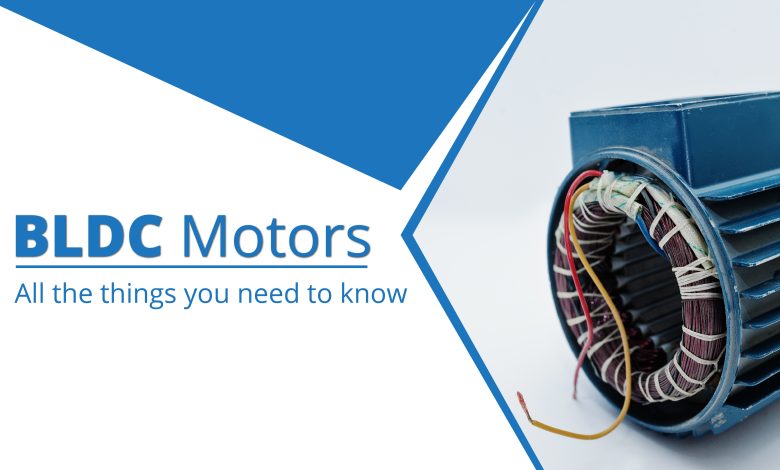BLDC motors- all the things you need to know

Because of the electronic commutation, brushless DC motors have notable benefits over rivals like brushed motors. It lets the controller quickly switch the current and effectively control the motor’s characteristics. From computer hard drives to electric transportation and industrial robotics, BLDC motors have a wide range of applications. This article will discuss the quirks of a brushless DC motor controller. You will discover how it functions and the design elements and difficulties you should be aware of before creating your gadget.
Principles of Operation for BLDC Motors and Controllers
A BLDC motor controller controls the motor’s speed, torque, and ability to start, stop, and reverse rotation. Let’s first look at the building of a brushless motor to understand the controller’s operating principles better. Its main parts are an armature or rotor constructed of permanent and, frequently, neodymium magnets and a stator with windings that, when charged, produce a magnetic field.
The motor rotates thanks to the rotor’s magnets and the stator’s windings. They are attracted to one another by their opposing poles and repulsed by their shared poles. A brushed DC motor goes through a similar process. The critical distinction is the method used to switch the current provided to the wire windings.
It is a mechanical action that a commutator with brushes initiates in a BDC motor. It occurs electronically with the use of transistor switches in a BLDC motor.
A BLDC motor controller determines the position of the rotor, either sensor less or with the aid of sensors (such as a Hall-effect sensor). The sensors take rotor position measurements and transmit this information. The information is sent to the controller, which then instructs the transistors to switch the current and energize the necessary winding of the stator at the appropriate moment.
BLDC motor and controller types
BLDC motors come in two different flavors depending on where the rotor is located:
- Out runner motors have an external rotor, which causes the permanent magnets to revolve around the stator along with the motor’s housing. In runner motors have an internal rotor and an external stator.
- Because of their smaller rotating diameter, in runners are more lightweight and have a faster rotational speed. Because of the longer arm and increased electromotive force imparted to the rotor, out runner motors have a larger torque during their turn.
- The technique used by different BLDC motor controllers to determine the position of the rotor varies. Position sensors and sensor less techniques are both options for making the measurements.
There are several choices available for sensors, including:
Optical sensors, resolvers, rotary encoders, variable reluctance sensors, and Hall-effect sensors. Without a sensor, the sensor less BLDC motor controller determines the position of the rotor by estimating the back electromotive force (back EMF). This is the voltage produced by the rotating armature in the stator’s windings. The rotor’s position can be ascertained by measuring the back EMF; the greater the back EMF, the closer the rotor’s magnet is.
The range of applications for BLDC motors and controllers
The main advantages of a brushless DC motor come from its design elements. Improved current switching is provided via electronic commutation. The motor performs better due to higher torque and good speed control across a wide range.
It is a low-maintenance and long-lasting solution since electronics are used in place of mechanical parts that wear out. Additionally, the lack of brushes results in minimal power loss, minimal electromagnetic interference (EMI), and minimal noise.
Because of this, BLDC motors are widely used in systems and devices with lengthy operational lifetimes, such as:
Some examples are industrial applications, electric cars, unmanned aircraft systems, computer hardware, consumer electronics, and robotics.
This arrangement allows BLDC motors to drive compact, high-performance electronics, which broadens the range of products for which they can be used.
Applications for BLDC motors
In fact, there are low-cost, low-power solutions that don’t require a feedback-equipped, programmable brushless DC motor controller. A BDC motor with a straightforward controller could be more appropriate in this case. However, if you still value greater efficiency and robustness over ease of use and cost-effectiveness, a brushless DC motor can be a good choice for your project.
Strong embedded software programming and circuit design skills are needed to build a BLDC motor controller. A control device may ensure the smooth operation of your motor and increase its lifespan if used appropriately. We’ll go into more detail about brushless DC motor controller design in part after this one.
Design of the BLDC Motor Controller Circuit
A half-bridge or half-H bridge circuit is found in most BLDC motor controllers. Unlike an H bridge, this circuit layout only includes two switches, one high-side and one low-side transistor.
Most brushless motors are powered by two- or three-phase electrical systems. In a BLDC motor controller circuit diagram, this will appear as two or three half-bridges with a pair of switches apiece, depending on the number of phases.
To see the fundamentals of its circuit design, let’s take a closer look at a three-phase brushless DC motor controller using Hall-effect sensors.
BLDC motor controller with three phases and Hall-effect sensors
Three-phase windings on the stator are 120 degrees apart from one another. Each winding is currently applied to the stator and has a vector voltage representation.
The Hall sensors on the BLDC motor controller determine the rotor’s position. The power MOSFETs switch the current and inject it into the right winding after receiving sensor data. MOSFETs can be swapped out for IGBTs, and GaN switches in a high-power brushless DC motor controller.
Standalone or integrated gate drivers can manage the transistors. The controller diagram is the drivers between the switches and the microcontroller in a brushless motor (MCU).
Six steps are included in the three-phase BLDC motor controller circuit to carry out a whole switching cycle (that is, to energize all the three windings of the stator). The current sequence that passes through the stator windings is controlled by switching the high-side and low-side transistors on and off.
When designing a BLDC motor controller, you can consider various current switching strategies, such as sinusoidal and trapezoidal commutation. These approaches’ names are associated with the signal waveforms.
Two windings can continue to be powered simultaneously with the trapezoidal commutation. The phase shift in the sinusoidal control approach complies with the rule of sines. It offers more seamless current switching between phases
The motor may vibrate at low speeds even though the trapezoidal commutation is simpler. Your motor will run without a hitch if sinusoidal current waveforms are used. However, at high speeds, this kind of commutation becomes difficult.
Pulse-width modulation is typically used in sinusoidal brushless motor controller circuits (PWM). It makes the commutation process run more smoothly and effectively and aids in controlling the current injected into the rotor’s windings. It is especially true for closed-loop controllers that change the duty cycle to change the input power after receiving feedback on the output signal.
The ratio of the current pulse to the entire cycle of the current signal is called the duty cycle. A BLDC motor speed controller modifies PWM duty cycles to provide sinusoidal signals.
The three-phase pulse-width modulation (PWM) switching frequency can vary for different applications. But it must be high enough to guard against power outages. The stator’s physical constraints determine the maximum frequency level. The specifications of the control unit itself are another thing, though.
Due to the DC brushless motor controller’s limited capabilities, you will be unable to increase the PWM frequency even if the stator permits you to do so.
Hysteresis is a possible method for managing the performance of a BLDC motor. This technique also applies to sinusoidal commutation. It enables you to set the maximum and minimum currents that should be provided to the motor. The transistor switches turn on or off to the current reaching its higher or lower range, changing the average current according to the law of sines.
A BLDC motor controller half-bridge can be implemented using discrete parts or an integrated circuit (IC). As you begin to consider how to construct a BLDC motor controller, this is likely to be one of the most frequent problems you encounter.
Since the components must be built and soldered onto the board separately, a discrete circuit may be less dependable. The design process is made simpler by the smaller size and lower production costs of a brushless DC motor controller IC. Integrated circuits, however, have power restrictions. In addition, if one component fails, the complete BLDC motor controller IC must be replaced rather than just this one component.
Position sensors offer a relatively simple detection method that you can implement without sophisticated control algorithms. However, their use complicates the arrangement and maintenance of the motor.
Making a BLDC Motor Speed Controller: A Challenge
Building a brushless DC motor controller circuit could run into certain difficulties. You must select the appropriate hardware and apply the necessary algorithms based on the functionality and application of the motor and pipe.
For instance, power electronics use BLDC motor controllers to handle large currents and voltage. A high switching frequency is necessary for them. Discrete parts are appropriate here, such as external high-power transistors like IGBT and GaN.
One of the main difficulties for any brushless motor controller is the precision of the rotor placement. It can be done by taking measurements with or without a sensor.
The sensor less approach (back EMF measurement) can lower the BOM cost and streamline the design of your brushless DC motor controller. Since back EMF won’t manifest itself when the rotor is at rest, the main issue in this situation is to make the rotor move first. As a result, the controller won’t get the necessary data.
Conclusion
For more than 50 years, brushless DC motors have been in use. They can be used for anything from tiny consumer electronics to intricate industrial automation systems. The all-electronic control system improves the motor’s other qualities, which also increases torque and promotes wide-range speed regulation.
Even though these motors are dependable and efficient, they are not utilized everywhere. They are expensive and have a complex controller setup to start. Consequently, a brushed DC motor controller can become a viable solution for some projects.
The development of brushless DC motor controls can be expensive and need creative hardware and software engineering solutions. Please feel free to contact us with your questions if you require expert assistance or suggestions on how to build your own BLDC motor controller.
Micro Care is one of the leading bldc motor spares and solar component parts manufacturers in India. Along with Micro Care is a BLDC Magnet Sleeve Exporter, Suppliers who are mainly known for providing excellent customer services and detailed instruction manuals.





